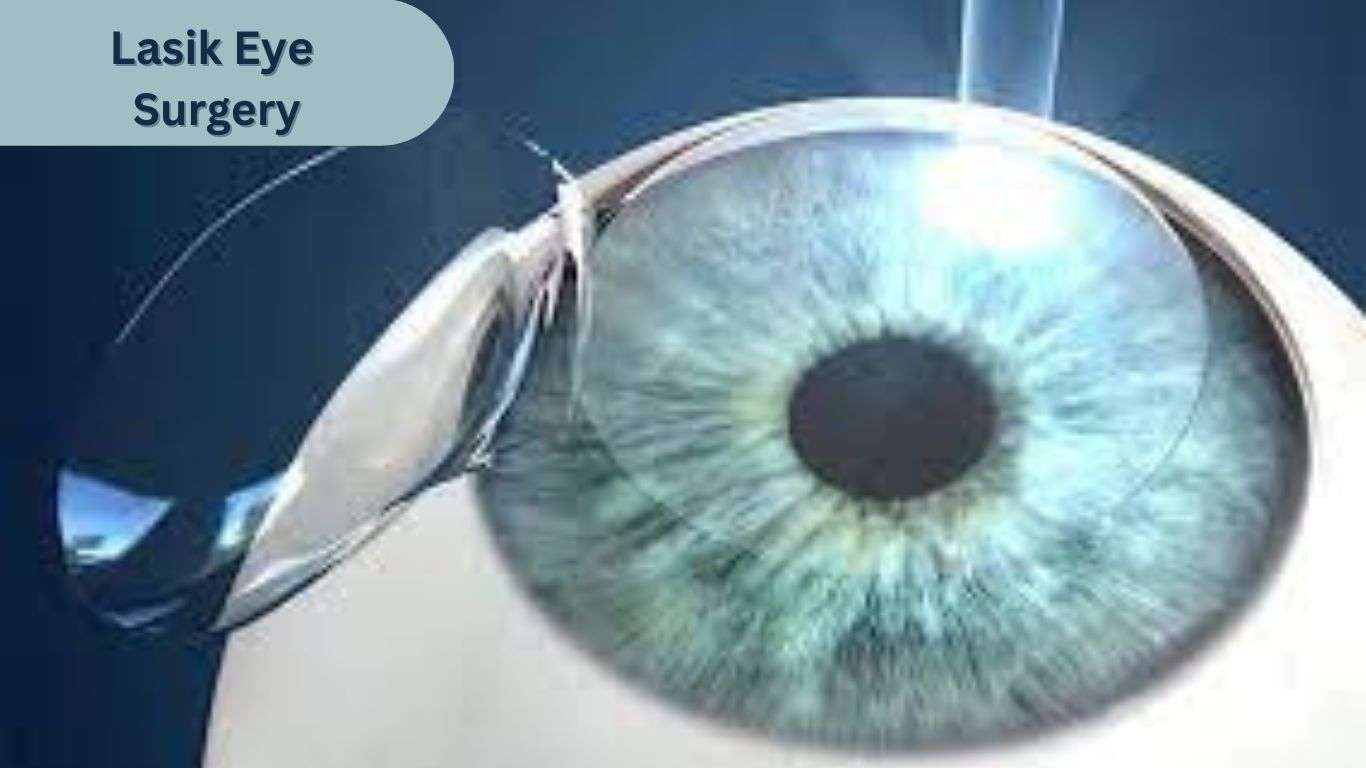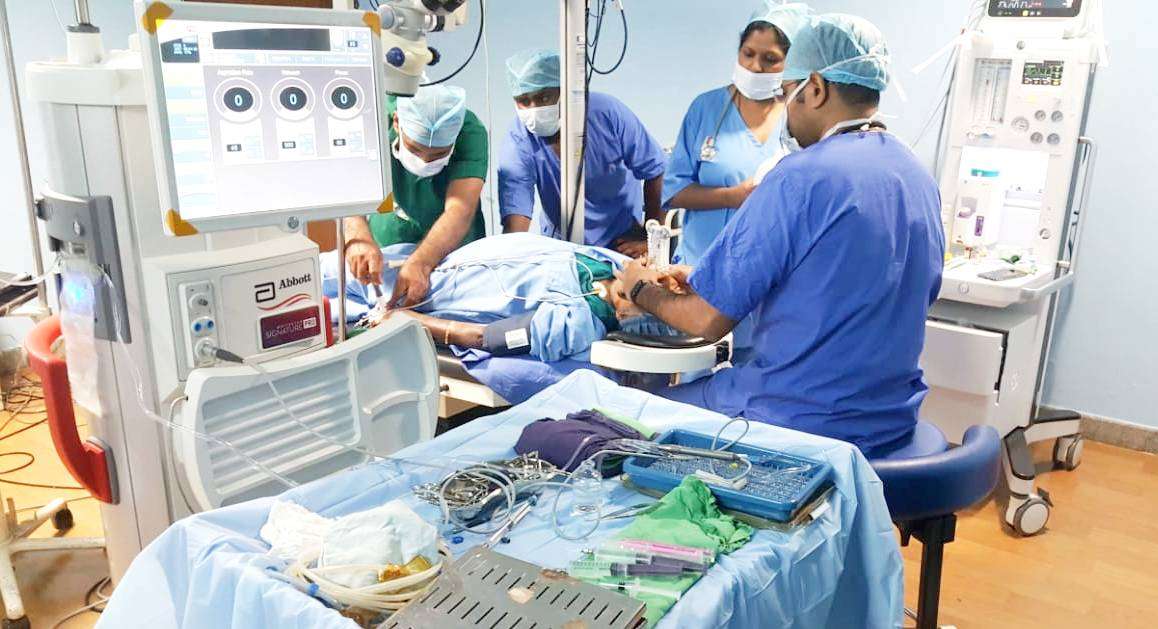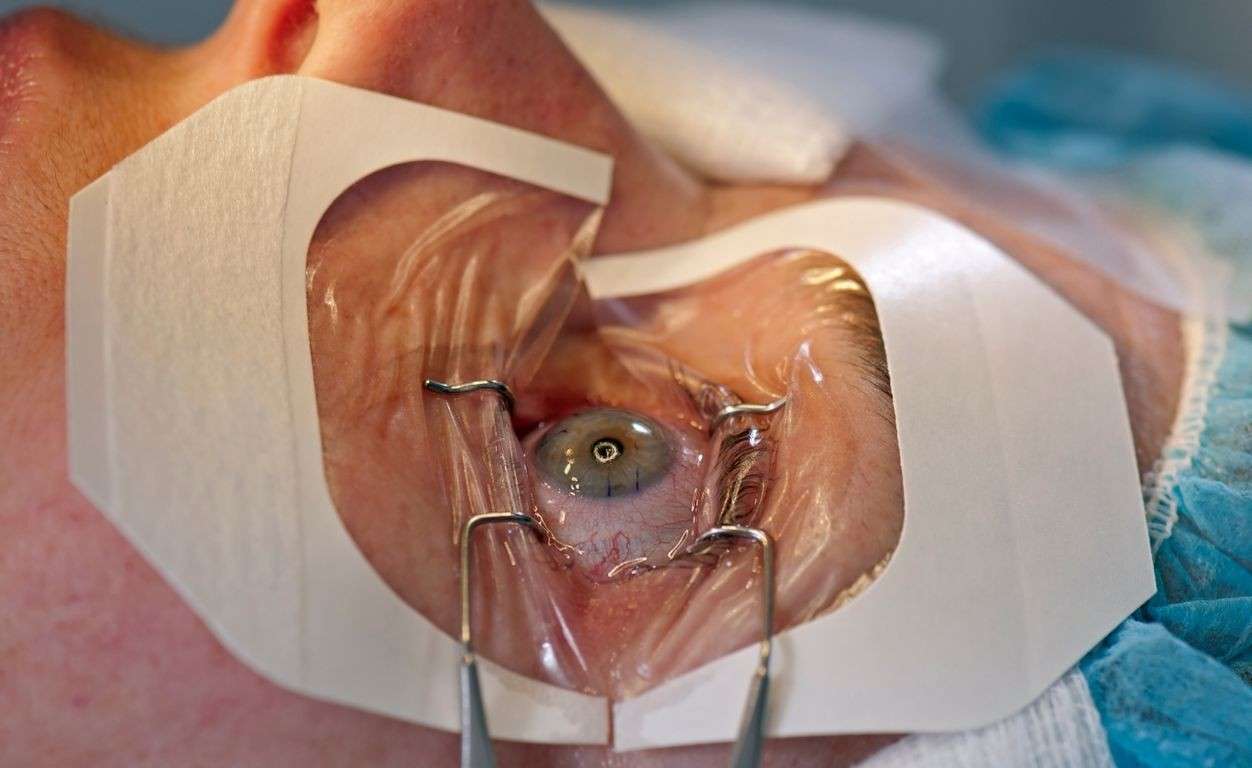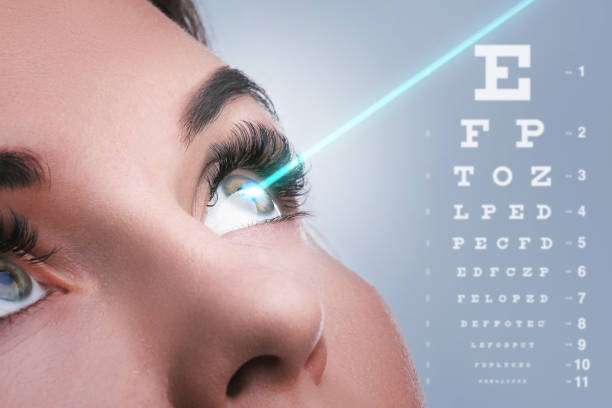What Lasik Eye Surgery?
LASIK eye surgery, otherwise known as laser-assisted in situ keratomileuses, is a commonly used laser-based eye surgery to fix common vision impairments such as nearsightedness, farsightedness, and astigmatism. Ophthalmologists originally combined the techniques of keratomileusis and photorefractive keratectomy in the early 1990s to create what we now know as LASIK. In keratomileusis, the cornea is removed, frozen, reshaped, and replaced. Whereas in PRK, a laser is used to directly reshape the cornea.

In the LASIK procedure, the corneal tissue is lifted and an excimer laser is used to reshape the underlying tissue. This helps the eye focus light better and reduces blurred vision. The natural adhesive properties of the corneal flap replaced negate the need for stitches. LASIK surgery is often preferred to photorefractive keratectomy for these reasons.
Why Lasik’s Surgery Is Done?
LASIK surgery may be an option to fix the following vision problems:
Nearsightedness (myopia) – If your eyeball is a bit longer than average, or if your cornea curves too sharply, light rays will focus in front of the retina. This blurs distant vision. You can see objects close by just fine, but things in the distance are blurry.
Hyperopia (farsightedness) is when you have a shorter-than-average eyeball or a cornea that is too flat, which makes light focus behind the retina instead of on it. This can cause blurry vision for both near and far objects.
Astigmatism is when the cornea curves or flattens unevenly, which disrupts the focus of near and distant vision.
Can You Be a Good Candidate For Lasik Surgery?
LASIK surgery requires patients to meet certain conditions in order to be eligible for the procedure. If you’re considering LASIK, make sure you meet the following requirements:
The ideal age for LASIK surgery is over 21 when vision is more likely to have stabilized. Your eye prescription should not have changed much in the last year, and your refractive error must be one that can be treated with LASIK. To be a candidate for LASIK, your corneas must be thick enough and healthy, and your overall eye health must be generally good. It’s important to have realistic expectations about what LASIK can and cannot do for you.
Types of Lasik surgery:
There are many types of laser eye surgery available Laser-assisted in situ keratomileuses (LASIK), Photorefractive keratectomy (PRK), Laser-assisted sub epithelial keratectomy (LASEK), Epithelial laser-assisted in situ keratomileuses (epi-LASIK), Small-incision lenticular extraction (SMILE).
LASIK surgery is a popular way to improve vision. This is because it has a quick recovery time and relatively little discomfort during the recovery period. More than 90% of patients who have undergone LASIK surgery would choose it again or recommend it to others. The majority of people who have LASIK surgery will have 20/20 vision the next day.
Since everyone’s eyes are different. LASIK is a type of refractive surgery that uses two lasers to reshape the cornea. It is blade-free and can treat myopia, hyperopia, astigmatism, and presbyopia. In the event, the treatment that one person is recommended by their eye surgeon may be different from another person. This is why it’s important to consult with a professional to determine the best course of action for you specifically.
PRK, or Photo Refractive Keratectomy, is a laser eye surgery technique used to treat myopia (nearsightedness), astigmatism, and presbyopia. The PRK technique is blade-free and can successfully treat and correct myopia (nearsightedness) and astigmatism. However, PRK is not suitable for moderate to high hyperopia (long-sightedness).
PRK was the first type of laser eye surgery for vision correction and is the predecessor to the popular LASIK procedure. PRK surgery is conducted in the same way as LASIK, however, the cornea is reshaped on the surface once the epithelial cells have been removed. At the end of the laser treatment, a bandage contact lens is used. Just like in LASIK, the same excimer laser is used for PRK. Although PRK and LASIK both use the same laser, PRK surgery requires a longer healing time. LASIK patients generally recover within 4-5 hours, while those who have undergone PRK surgery can expect a recovery time of 4-5 days. The final improvement from PRK surgery is also seen over a course of 3-4 weeks.
If you’re considering LASEK surgery to improve your vision, it’s important to understand how the procedure works. LASEK (laser-assisted sub-epithelial keratomileusis) is similar to PRK (photo-refractive keratectomy). In both procedures, the top layer of the cornea (epithelium) is separated from the underlying tissue (stroma). However, in LASEK, the thin epithelial flap is not completely removed and discarded. Instead, it is pushed to one side of the cornea, where it remains attached. This is similar to the thicker flap created during LASIK surgery.
EPI-LASIK is a variation of the PRK procedure. The epi-LASIK flap is a lot like the thin flap created during a LASEK surgery. For both procedures, the flap only contains cells from the very thin outer layer of the cornea – known as the epithelium. The main difference is how the epi-LASIK and LASEK flaps are produced. It can be treated Refractive surgery treating Myopia, Astigmatism, Presbyopia.
SMILE, which stands for Small Incision Lenticule Extraction, is a new technique for treating high myopia. It is blade-free and uses one femtosecond laser. SMILE uses the laser to create a lens-shaped disc of tissue within the cornea. This disc of tissue is called a ‘lenticular’ because it is lenticular in shape, this is removable. The lenticular size and shape are adjusted to the refractive error of the patient. The laser eye surgeon removes the lenticule through a 4-5mm incision on the cornea. The removal of tissue from the cornea helps to change its shape and flatten it. This, in turn, improves vision.
Lasik eye surgery – discover the procedure:

There are a few things you can do to prepare for surgery, such as:
1. Know what you may have to pay for the surgery. LASIK is usually considered an elective surgery, so most insurance companies won’t cover the cost. Have some money saved up to cover any unexpected expenses.
2. Arrange for a ride home. You’ll need someone to drive you to and from your place of surgery. Immediately following surgery, you may still feel the effects of anesthesia given to you before the operation. Additionally, your vision may be blurry.
3. Take some time off work. Depending on the type of surgery you’re having, you might need a day or two – or even a week – to recover. Talk to your boss in advance about taking some time off and make sure everything at work will be covered while you’re gone.
4. Skip the eye makeup, cream, perfumes, and lotions two days before and on the day of your surgery. Your doctor may also instruct you to clean your eyelashes daily or more often in the days leading up to surgery, to remove debris and reduce your risk of infection.
What to do before you get it done?
Based on your lifestyle, you and your ophthalmologist will discuss your vision needs. For example, if you play sports, you may want to achieve clear distance vision with surgery.
You and your ophthalmologist should also talk about your expectations for LASIK. People who want perfect vision without glasses or contacts after surgery might be disappointed. This laser eye surgery usually allows people to do most everyday tasks without corrective lenses. However, you might need to wear glasses for some activities, such as reading or driving at night.
Your ophthalmologist will give you a thorough examination to ensure that you are a prime candidate for LASIK surgery. This is what the examination will entail:
Testing your vision. This is to establish that your vision has not changed and to gauge the severity of your refractive error. Checking for other eye problems. Your ophthalmologist wants to confirm that you do not have any other eye conditions because they could interfere with the surgery or make post-operative recovery more difficult. For example, if you suffer from dry eyes, LASIK surgery could exacerbate the condition.
The first step in preparing for LASIK surgery is to have your cornea measured and mapped. Your ophthalmologist will take a thorough look at your cornea, checking its thickness and making precise measurements of its surface. These measurements are used by your eye surgeon to program the computer-based laser that will be used during the surgery.
In addition to measuring your cornea, your ophthalmologist will also measure the size of your pupil. If your pupil is very large, you could experience halos (rings of light) at night after the surgery.
What to expect during Lasik surgery?
This laser eye surgery can be performed in an outpatient surgery center or at your ophthalmologist’s office. Your eye surgeon will use a laser to accurately reshape your cornea. Here is a detailed explanation of what you can expect during the procedure:
Your eye will be numbed with eye drops to ensure your comfort.
Your eye surgeon will place an eyelid holder on your eye to keep you from blinking and a suction ring on your eye to keep it from moving. You may feel pressure on your eyelid, but it should not be painful. At this point, your vision may start to go dim or black.
Your ophthalmologist will use either a device called a microkeratome or a laser to cut a paper-thin flap in your cornea tissue. Once the flap has been cut, he or she will lift and fold it back. You will be asked to stare at a target light during this surgery so that your eyes will not move. The ophthalmologist will then use a laser, programmed with specific measurements for your eye, to reshape your cornea.
While your ophthalmologist uses the laser, you may hear a clicking sound. After reshaping the cornea, your eye surgeon will fold the flap back down into position and smooth the edges. The flap typically heals in place within 2–3 minutes.
The LASIK procedure from start to finish usually takes about 20 minutes. To ensure your safety, please plan to have someone drive you home after surgery.
After Lasik Surgery?
The ophthalmologist will place a clear shield over your eye or ask you to wear a shield while sleeping for the next few days, this is to help protect your eye while it heals.
You should plan to go home and take a nap or relax after the surgery. For a few hours, your eyes may feel scratchy or like they are burning.
You will be given special eye drops to reduce dryness and help your eye heal.
Results Of Lasik Surgery:
LASIK offers many people the benefits of improved vision without needing to wear corrective lenses like glasses or contact lenses. You have a very good chance of achieving 20/25 vision or better after undergoing refractive surgery. This type of surgery is becoming increasingly popular as it can effectively improve a person’s vision.
More than 8 out of 10 people who have had LASIK refractive surgery no longer need to use their glasses or contact lenses for most activities.
It’s important to keep in mind that LASIK can’t fix presbyopia, which is the natural, age-related decline in near vision. With or without refractive surgery, almost everyone will need reading glasses once they hit around age 40.
Risks Factors:
LASIK is a surgery, and like any surgery, it comes with certain risks and potential complications.
Some people who have LASIK report having side effects afterward that usually go away after some time. However, there are rare cases where these symptoms may not go away. For example, almost everyone who has LASIK will experience dry eyes and changing vision during the day. These symptoms usually subside within a month. But for some people, they may take longer to disappear or they may even be permanent.
Other potential side effects, which could be either temporary or permanent, may include:
– Discomfort or pain in the eyes
– Vision that appears foggy, blurry, or hazy
– Itchy eyes
– Increased sensitivity to light
– Small pink or red patches of blood on the whites of the eyes that eventually go away
– Rings or starbursts of light around objects (halos)
Other rare risks that have been associated with LASIK surgery include:
– Infection in the eye
– Loss of best-corrected vision, which is when your vision is worse than it was before the surgery, even with glasses or contact lenses
– Blindness
About Author:

Dr. Sushruth Appajigowda is a well-known Cornea, Cataract, and LASIK Surgeon in Bangalore, and the chief Cataract and Refractive surgeon at Vijaya Nethralaya Eye Hospital, Nagarbhavi Bangalore. Known as one of the best LASIK surgeons in the country, he has over 10+ years of experience with multiple platforms of LASIK like ZEISS, ALCON, SCHWIND, AMO, and Bausch and Lomb. He has conducted over 5000 LASIK and over 300 Collagen cross linking procedures. Dr Sushruth is a recognized speaker in various National and International Forums. His expertise lies in choosing the right procedure based on your health requirement. You can schedule an appointment by scanning the QR Below or clicking the link below the QR





